This site is supported by our readers. We may earn a commission, at no cost to you, if you purchase through links.

The solution isn’t just about how you shave, but what you shave with. The right shaving cream for ingrown hairs creates a protective barrier that allows your razor to glide smoothly while delivering ingredients that soften hair, calm inflammation, and keep follicles clear. Here are nine dermatologist-recommended options that actually prevent those frustrating bumps before they start.
Table Of Contents
- Key Takeaways
- Why Ingrown Hairs Occur After Shaving
- Key Ingredients in Shaving Creams for Ingrown Hairs
- Top 9 Shaving Creams for Ingrown Hair Prevention
- 1. Flamingo Aloe Vera Shaving Gel
- 2. Aveeno shave gel for sensitive skin
- 3. Lavender Bergamot Whipped Shave Cream
- 4. Skintimate dry skin shave gel
- 5. Shea Better Dry Skin Shaving Cream
- 6. Venus Intimate Grooming Shave Gel
- 7. Luxurious Almond Shave Cream
- 8. Philips Norelco Wet Dry Shaver
- 9. Philips Norelco Rechargeable Electric Shaver
- Shaving Techniques to Prevent Ingrown Hairs
- Treating and Soothing Existing Ingrown Hairs
- Expert Tips for Long-Term Ingrown Hair Prevention
- Frequently Asked Questions (FAQs)
- Should you use a shave cream if you have ingrown hair?
- How do you prevent ingrown hairs if you shave?
- Can a shave cause ingrown hairs?
- Does shaving cream help with ingrown hair?
- What cream is best for ingrown hairs?
- How do you shave down there to prevent ingrown hairs?
- How often should I replace my razor blade?
- Can certain fabrics worsen ingrown hairs after shaving?
- Are there natural remedies for preventing ingrown hairs?
- Do hormonal changes affect ingrown hair frequency?
- Conclusion
Key Takeaways
- Ingrown hairs happen when cut hair curls back into skin instead of growing outward—a problem amplified by coarse or curly hair textures, dead skin cell buildup, and improper shaving technique that creates sharp edges.
- The best shaving creams for preventing ingrown hairs contain moisturizing agents (shea butter, aloe vera, glycerin) that create a protective glide, anti-inflammatory ingredients (chamomile, marshmallow root) that calm irritation, and chemical exfoliants (fruit acids, salicylic acid) that keep follicles clear.
- Prevention requires more than just product choice—you need to prep skin with warm water and exfoliation, always shave with the grain using light pressure with a sharp blade, and follow up with alcohol-free moisturizer within minutes of shaving.
- If ingrown hairs persist beyond a week, show signs of infection (pain, warmth, pus), or keep recurring in the same spots, see a dermatologist for prescription treatments or laser hair removal that can break the cycle permanently.
Why Ingrown Hairs Occur After Shaving
You’ve probably dealt with those annoying red bumps after shaving and wondered why they keep showing up. Understanding what causes ingrown hairs is your first step toward preventing them for good.
Let’s break down the main culprits behind those post-shave irritations.
Hair Growth Patterns and Follicle Structure
Your hair’s structure plays a huge role in Razor Bump Prevention and Ingrown Hair Treatment. Here’s what happens beneath your skin:
- Follicle Anatomy: Each follicle contains stem cells in the bulge region that drive Follicle Regeneration throughout your life
- Growth Phases: Hair cycles through anagen (active growth), catagen shift, and telogen (resting) phases
- Cellular Structure: The cortex makes up 75% of each shaft, while keratin provides rigidity
- Hair Texture matters: Curly hair shows greater subcutaneous curvature, especially prone to Folliculitis
- Emergence angles: Follicles emerge at varying angles depending on body location—misaligned cuts from Hair Removal cause Ingrown Hairs
Understanding the hair follicle basics is vital for effective ingrown hair prevention and treatment.
Impact of Dead Skin Cells on Follicles
Dead skin cells are the sneaky culprits that can turn your follicles into roadblocks, trapping new hair beneath the surface before it has a chance to emerge. When these cells accumulate, they block your pores and force growing hairs to curl back under your skin—hello, Ingrown Hairs.
Regular Skin Exfoliation through Dead Cell Removal is your best defense for Follicle Health and Ingrown Prevention. A quality Shave Cream with exfoliating properties helps maintain Pore Cleansing, reducing Razor Burn while supporting overall Skin Care.
Role of Coarse and Curly Hair Types
If you’ve got coarse or curly hair, you’re already working with a texture that naturally wants to bend back toward your skin—and that makes you way more prone to ingrowns than someone with fine, straight strands. Here’s how Hair Texture Impact plays out:
- Curly Hair Care requires extra attention since curled strands easily re-enter Follicle Structure
- Coarse Hair Shaving demands quality Shaving Cream for proper cushioning
- Razor Burn intensifies without proper lubrication during Hair Removal
- Shave Cream with anti-inflammatory ingredients aids Ingrown Hair Prevention
- Regular exfoliation combats Ingrown Hairs before they form
Common Problem Areas for Ingrown Hairs
Certain spots on your body—like your bikini line, underarms, neck, and legs—turn into ingrown hair hotspots because the hair there is usually coarser, the skin experiences more friction, and those areas are under constant pressure from clothing or movement.
Here’s where ingrown hairs strike most:
| Problem Area | Why It’s Vulnerable |
|---|---|
| Bikini Area & Pubic Region | Coarse, curly hair meets tight clothing friction—perfect storm for trapped follicles |
| Arm Pits | Constant movement and moisture create ideal conditions for razor burn and ingrown hairs |
| Neck & Leg Follicles | Multi-directional hair growth patterns make proper hair removal tricky without quality shaving cream |
Smart skin care and the right technique make all the difference.
Key Ingredients in Shaving Creams for Ingrown Hairs
Not all shaving creams are created equal regarding preventing ingrown hairs. The difference often comes down to what’s actually inside the bottle.
Let’s break down the key ingredients that make certain formulas stand out from the rest.
Moisturizing Agents for Smoother Shaves
Your razor glides best when there’s a protective cushion between blade and skin, and that’s where moisturizing agents step in to do the heavy lifting. These hydrating ingredients create a slick barrier that prevents tugging and razor drag—two major culprits behind ingrown hairs.
Look for shave creams with:
- Aloe vera – calms irritation while maintaining moisture balance
- Shea butter – conditions skin and softens coarse hair before the blade passes
- Natural oils (olive, coconut, sweet almond) – lock in hydration for aftershave care
- Glycerin – pulls water into your skin for a smoother, bump-free finish
Anti-inflammatory and Antimicrobial Ingredients
Inflammation fuels the cycle of ingrown hairs, so anti-inflammatory agents like aloe vera and chamomile extract work to calm redness and swelling after each pass of the blade. Botanical extracts—including marshmallow root—deliver antimicrobial protection against bacteria that worsen bumps and folliculitis.
Natural antimicrobials like tea tree oil target skin pathogens without disrupting your microbiome, while synthetic preservatives keep shave cream formulas stable and contamination-free for months.
To prevent ingrown hairs, consider using products with ingredients that support ingrown hair treatment and follow proper hair removal strategies.
Avoiding Irritants and Harsh Chemicals
Many shaving creams hide troublemakers—synthetic fragrances, sulfates, and alcohol—that strip your skin’s natural barrier and turn a simple shave into an irritation flare-up. Check labels for phthalates and parabens, toxic substances linked to hormone disruption and skin irritation.
Instead, choose gentle formulas with natural ingredients like aloe vera and shea butter that protect against ingrown hairs without chemical aggression. Your skin deserves chemical-free care that works with—not against—its natural defenses.
Specialized Formulas for Sensitive Skin
If sensitive skin turns every shave into a gamble, specialized gentle formulas with natural ingredients become your safety net. Look for fragrance-free shaving cream packed with skin barrier protectors like glycerin and hyaluronic acid—these shave cream ingredients reduce reactions by up to 48% compared to standard products.
Dermatologically tested options with aloe and oatmeal don’t just prevent ingrown hairs; they actively calm inflammation and support your skin care routine without compromising protection.
Top 9 Shaving Creams for Ingrown Hair Prevention
Finding the right shaving cream can make all the difference when you’re battling ingrown hairs. We’ve tested and reviewed nine standout options that combine protective ingredients with smooth glide to help you achieve bump-free results. Here’s what actually works.
1. Flamingo Aloe Vera Shaving Gel
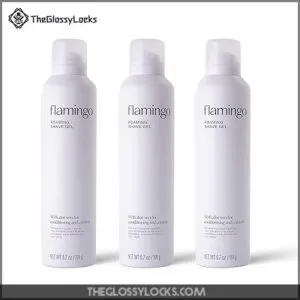
If you’ve struggled with bumps and irritation, Flamingo Aloe Vera Shaving Gel might be your answer. This cruelty-free product transforms from gel to foam, creating a protective cushion that prevents ingrown hairs before they start.
The aloe and bisabolol calm your skin while five fruit acids gently exfoliate, freeing trapped hairs. It’s dermatologist-tested for sensitive skin care and works beautifully on tricky areas like your bikini line.
The natural ingredients deliver real results—71% of users report smoother shaves with fewer bumps. At $18.57, this shaving cream proves effective ingrown hair prevention doesn’t require harsh chemicals.
Best For: Anyone dealing with ingrown hairs and razor bumps who wants a gentle, dermatologist-tested shave gel that works on sensitive areas like the bikini line.
- Five fruit acids exfoliate to prevent trapped hairs while aloe and bisabolol calm irritation—71% of users report fewer bumps and smoother results
- Clear gel-to-foam formula lets you see where you’re shaving, reducing nicks in tricky spots while creating a protective cushion between skin and blade
- Free of parabens, sulfates, and harsh alcohols, plus it’s dermatologist and gynecologist-tested for use on delicate skin zones
- At $18.57, it’s pricier than drugstore alternatives, which might not fit every budget
- The rich, creamy texture means you might go through bottles faster than expected, increasing long-term costs
- Limited to a citrus scent, so it won’t work if you prefer unscented products or different fragrance profiles
2. Aveeno shave gel for sensitive skin
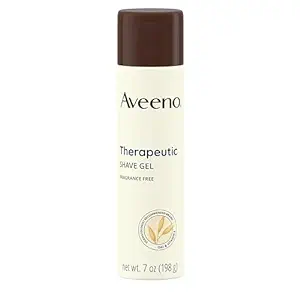
When dry, irritated skin drives you to despair, Aveeno’s Therapeutic Shave Gel offers real relief. This fragrance-free formula combines colloidal oatmeal and vitamin E to create a protective barrier that calms inflammation and prevents razor bumps before they form.
The gentle formula earned a 4.7-star rating from over 15,000 users who struggled with ingrown hairs. Dermatologists recommend it specifically for sensitive skin because it’s free from harsh alcohols, sulfates, and common allergens. The moisture-rich gel transforms into a cushioning lather that helps your razor glide smoothly without traumatizing hair follicles.
At just $3.96 for seven ounces, Aveeno delivers dermatologist-endorsed protection without breaking your budget.
Best For: People with dry or sensitive skin who struggle with razor bumps, ingrown hairs, and post-shave irritation.
- Fragrance-free formula with colloidal oatmeal and vitamin E soothes sensitive skin and reduces inflammation without harsh chemicals or common allergens
- Creates a protective, lubricating lather that helps prevent nicks, razor burn, and ingrown hairs while allowing a close shave
- Extremely affordable at $3.96 for 7 ounces with strong dermatologist endorsement and a 4.7-star rating from over 15,000 users
- Specifically formulated for dry and sensitive skin, so may not be ideal for other skin types
- Some users report occasional product leakage due to packaging issues during shipping
- A few customers mention detecting a slight scent despite the fragrance-free label
3. Lavender Bergamot Whipped Shave Cream
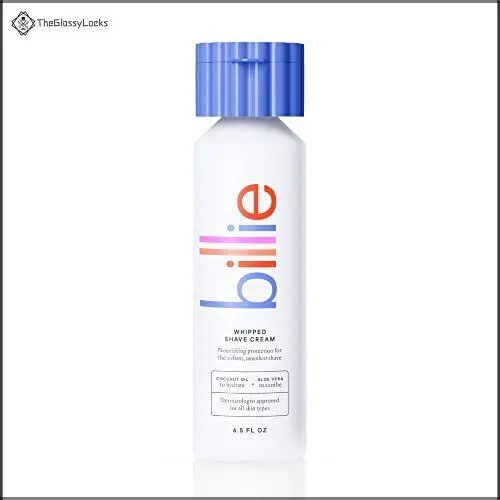
Billie’s Whipped Shave Cream pairs lavender and bergamot with clinical-grade ingrown hair prevention. This vegan, aerosol-free formula blends shea butter, coconut oil, and aloe into a featherlight texture that cushions your razor without clogging follicles. The natural ingredients deliver anti-inflammatory protection while glycerin locks in moisture more effectively than hyaluronic acid.
With 4.5 stars from over 9,300 users, this dermatologist-approved cream works on sensitive areas like your bikini line and face. At $6.50 for 6.5 ounces, you’re getting reef-safe, cruelty-free protection that actually prevents bumps—not just promises smooth skin.
Best For: Anyone with sensitive skin or prone to ingrown hairs who wants a dermatologist-approved, vegan shave cream that works on all body areas including the bikini line and face.
- Clinical-grade formula with shea butter, coconut oil, and aloe prevents razor burn and ingrown hairs while delivering superior moisture retention compared to hyaluronic acid
- Dermatologist-approved and 91% top allergen-free (no parabens, sulfates, synthetic fragrances) making it safe for sensitive skin and all body areas
- Strong user satisfaction with 4.5 stars from 9,300 reviews and affordable at $6.50 for 6.5 ounces
- Doesn’t foam like traditional shaving creams, which some users may miss if they prefer a bubbly lather
- Lavender and bergamot scent may not appeal to everyone’s personal fragrance preferences
- Higher price point than drugstore shaving creams, though the quality ingredients justify the cost
4. Skintimate dry skin shave gel
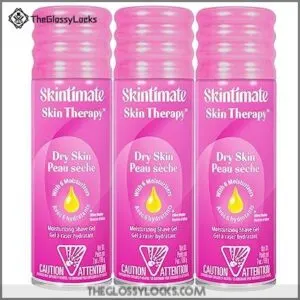
Skintimate Skin Therapy Dry Skin Shave Gel targets the root cause of ingrown hairs—dehydrated skin that drags your razor. Six moisturizers, including lanolin, olive butter, and vitamin E, create a protective cushion that lets blades glide without trauma.
This dermatologist-tested formula earned 4.6 stars from 551 users who noticed fewer bumps and razor burn after two weeks. The PETA-certified gel transforms into a creamy lather that shields follicles from nicks, the hidden culprit behind ingrown hairs.
At around $3 per bottle, it’s proof that effective sensitive skin care doesn’t require luxury pricing.
Best For: People with dry, sensitive skin who struggle with razor burn, irritation, and ingrown hairs from shaving.
- Six moisturizers (lanolin, olive butter, vitamin E) create a protective barrier that reduces nicks, cuts, and ingrown hairs while hydrating dry skin
- Dermatologist-tested, paraben-free, and PETA-certified formula is gentle enough for daily use on sensitive skin
- Affordable at around $3 per bottle with strong user ratings (4.6/5 stars from 551 reviews) for reducing bumps and irritation
- Strawberry scent may not appeal to everyone’s fragrance preferences
- Some users reported packaging issues with breakage or difficulty dispensing the gel
- Value ratings are lower (3.1/5) suggesting mixed opinions on overall quality relative to price
5. Shea Better Dry Skin Shaving Cream
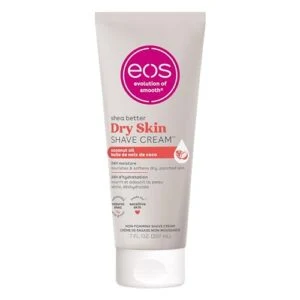
EOS Shea Better Dry Skin Shaving Cream proves that 24-hour hydration isn’t marketing hype—it’s ingrown hair prevention at work. Shea butter and shea oil soften coarse hair before blades even touch your skin, letting follicles release cleanly instead of curling inward.
The non-foaming texture gives you visibility to shave precisely, reducing the micro-trauma that traps hairs beneath the surface. With colloidal oatmeal calming redness and aloe vera soothing post-shave irritation, this hypoallergenic formula earned 4.5+ stars from users battling sensitive skin breakouts.
Dermatologists recommend it for bikini lines and other high-risk zones where ingrown hairs usually flare.
Best For: People with dry, sensitive skin prone to ingrown hairs who need a hypoallergenic shaving cream that hydrates for 24 hours while reducing razor bumps and irritation.
- Shea butter and oil soften hair before shaving, helping prevent ingrown hairs by reducing friction and allowing cleaner follicle release
- Non-foaming texture provides visibility for precise shaving and contains colloidal oatmeal plus aloe vera to calm redness and irritation
- Hypoallergenic, paraben-free, and dermatologist-recommended for sensitive areas like the bikini line, with 4.5 star ratings from users
- Thick, clumpy consistency requires frequent razor rinsing during use, which can slow down your shave routine
- Strong coconut scent may irritate users sensitive to fragrances, despite being marketed for sensitive skin
- Higher price point at $15.99 compared to standard shaving creams, and some users report it doesn’t provide enough moisture for very dry skin
6. Venus Intimate Grooming Shave Gel

Gillette Venus Intimate Grooming Shave Gel addresses ingrown hairs where they’re most stubborn—your bikini line. The clear gel formula lets you see exactly where you’re shaving, preventing the repeated strokes that irritate follicles and trap hairs beneath the surface.
Dermatologist and gynecologist tested, it’s pH-balanced specifically for pubic skin’s unique needs. The gentle, fragrance-free formula glides smoothly to protect sensitive areas from razor burn, while its 2-in-1 design works as both cleanser and shave gel.
Users report softer skin with fewer bumps, though some find the bottle tricky to squeeze when it’s nearly empty.
Best For: Anyone shaving sensitive bikini line areas who wants to prevent razor burn, ingrown hairs, and irritation with a clear, pH-balanced gel that doubles as a cleanser.
- Clear gel formula lets you see exactly where you’re shaving to avoid repeat strokes that cause ingrown hairs
- PH-balanced and dermatologist-tested specifically for pubic skin, free of harsh ingredients like parabens and fragrances
- Works as both shave gel and daily cleanser, saving you money and shower space
- Bottle design makes it hard to squeeze out product when you’re running low
- Some users found it didn’t provide enough glide, making shaving more difficult
- Higher price point compared to regular shave gels, and the bottle could be bigger for the cost
7. Luxurious Almond Shave Cream

LATHER’s Luxurious Almond Shave Cream takes a minimalist approach to ingrown hair prevention—it’s what’s missing that matters. This non-foaming formula skips parabens, sulfates, and synthetic fragrances that can inflame follicles and trap hairs beneath irritated skin.
Glycerin and vitamin E-rich almond oil create serious glide without excess lather, letting your razor move smoothly along hair’s natural growth pattern. That ingredient science translates to fewer nicks and redirected hairs. The concentrated texture means you’ll use less product per shave, though some find the $26 price steep.
Best for sensitive skin that rebels against heavily scented shaving creams and chemical-laden formulas.
Best For: People with sensitive skin who need a clean, fragrance-free shave cream that won’t trigger irritation or worsen ingrown hairs.
- Non-foaming formula with glycerin and almond oil provides smooth glide that helps prevent razor bumps and ingrown hairs by reducing friction and irritation
- Free from parabens, sulfates, and synthetic fragrances that can inflame follicles and trap hairs under the skin
- Highly concentrated texture means you’ll use less per shave, and the moisturizing properties reduce the need for post-shave products
- At $26, it’s pricier than drugstore options, which some users feel doesn’t justify the cost
- Non-foaming texture takes adjustment if you’re used to traditional lather, and may not work well for those who prefer that experience
- Some users report receiving dried-out products or finding the almond scent stronger than expected despite the “unscented” label
8. Philips Norelco Wet Dry Shaver
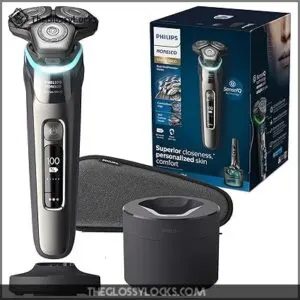
Electric shaving offers a different path to preventing ingrown hairs—no shaving cream needed. The Philips Norelco Shaver 9000 uses AI-powered SenseIQ Technology and dual rotary blades that adjust to your face’s contours, cutting hair without pulling or forcing it beneath the skin’s surface.
The Nano SkinGlide coating reduces friction during wet or dry shaves, while the Pressure Guard Sensor prevents you from pressing too hard—a common trigger for ingrown hairs.
At $259.99, shaver maintenance involves regular cleaning with the included Quick Clean Pod. Best for those seeking hair removal without chemical irritants, though the rotary blade system requires patience during your first few shaves to achieve ideal shave comfort.
Best For: People with sensitive skin prone to ingrown hairs who want a friction-free shave without shaving cream and are willing to invest in advanced electric technology.
- SenseIQ Technology and Pressure Guard Sensor adapt to your face and prevent pressing too hard, reducing the risk of hair being forced beneath the skin
- Nano SkinGlide coating minimizes friction during wet or dry shaves, helping prevent irritation that can lead to ingrown hairs
- 360-degree rotating blades follow facial contours without pulling hair, a key factor in avoiding ingrown hairs
- At $259.99, it’s a significant upfront investment compared to traditional razors
- The rotary blade system has a learning curve and may not provide complete hair removal in a single pass initially
- Some users report cuts or nicks during first uses, which could potentially create conditions for ingrown hairs if skin isn’t properly prepared
9. Philips Norelco Rechargeable Electric Shaver
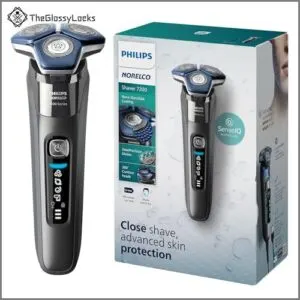
The Philips Norelco Rechargeable Electric Shaver (Model S7887/82) delivers up to 90,000 cutting actions per minute through SteelPrecision rotary blades that lift hair above skin level—preventing the downward curl that causes ingrown hairs. Its 250,000 micro-tech beads per square centimeter create a smooth glide coating that reduces friction by 30%, protecting sensitive areas prone to razor bumps.
Fully flexible heads contour to your face in five directions, eliminating repetitive passes that stress skin. With 60 minutes of cordless runtime and wet-dry capability for pairing with shaving creams or gels, this electric shaver offers long-term ingrown hair prevention.
Shaver maintenance is simple—waterproof construction allows quick rinses, and blades stay sharp for 24 months.
Best For: People with sensitive skin who struggle with ingrown hairs and razor bumps from traditional razors and want a low-maintenance electric shaver that works wet or dry.
- 90,000 cutting actions per minute with rotary blades that lift hair above skin level, reducing ingrown hairs and irritation
- 60 minutes of cordless runtime with quick 5-minute emergency charge option for one full shave
- Waterproof design works wet or dry with gels and foams, plus flexible heads contour to your face in five directions for fewer passes
- Replacement blades cost $35 and need changing every 24 months
- No travel case or wall adapter included—just a USB-A charging cable
- Some users report the independent rotating heads feel awkward or cause nicking during use
Shaving Techniques to Prevent Ingrown Hairs
The best shaving cream won’t help if your technique works against you. Your approach matters just as much as the products you use.
Here’s how to shave in a way that keeps ingrown hairs from forming in the first place.
Pre-shave Preparation and Exfoliation
Think of pre-shave prep as laying the groundwork for your best shave—skip it, and you’re practically inviting ingrown hairs to set up camp on your skin.
Start by softening hair and skin with warm water, then exfoliate using gentle skin exfoliants or exfoliation tools to clear dead cells blocking follicles.
Pre-shave oils can add extra slip for shave-ready skin preparation, making preventing ingrown hairs easier when paired with quality shaving cream ingredients.
Shaving With The Grain and Even Pressure
Shaving against the grain might seem like the fast track to smooth skin, but it’s actually one of the quickest ways to turn your razor into an ingrown hair factory.
Instead, follow your hair growth direction with light, even razor pressure—no skin tension required. This shave angle paired with quality shaving creams gives you glide control that protects follicles while delivering smooth results, making it one of the most vital shaving tips for skin care.
Choosing The Right Razor for Your Skin
Your razor choice matters just as much as your technique—maybe more—when you’re fighting back against ingrown hairs. Here’s what to prioritize for your skin type:
- Multi-blade vs. single-blade: Sensitive skin prone to razor bumps? Single-blade razors reduce follicle irritation and ingrown hairs.
- Sharp blade maintenance: Dull blades tug hair instead of cutting cleanly, increasing ingrown hair risk—replace based on shaving frequency.
- Grip and control: Razor grip materials like rubber or textured metal give you the blade angle adjustment needed for even pressure.
- Electric shavers: Consider wet-dry electric options for coarse hair types that curve back into skin easily.
Post-shave Care and Moisturizing
Once you’ve put down that razor, what happens in the next five minutes can make or break your efforts to keep ingrown hairs at bay. Rinse with cool water to close pores, then pat—don’t rub—skin dry.
Apply an alcohol-free after shave or moisturizer packed with soothing remedies like aloe vera within minutes. Skin hydration is your best defense: moisturizer benefits include softening hair follicles and preventing those sharp ends from burrowing back into skin.
Treating and Soothing Existing Ingrown Hairs
Already dealing with ingrown hairs? Don’t worry—you’re not stuck with them. The right approach can calm inflammation, clear blocked follicles, and get your skin back on track.
Here’s what actually works when ingrowns have already shown up.
Spot Treatments for Ingrown Hair Bumps
When an ingrown hair strikes, targeted spot treatments can calm inflammation and help coax that trapped hair back to the surface. Look for after shave products with salicylic acid or glycolic acid to gently dissolve dead skin cells blocking the follicle.
Benzoyl peroxide-based ingrown remedies fight bacteria and reduce redness, while hydrocortisone creams tackle inflammation.
Apply spot care treatments twice daily on razor bumps until the hair emerges—persistence pays off for bump reduction and clearer skin.
Effective Exfoliation Methods
Beyond spot treatments, regular exfoliation clears the path for trapped hairs. Physical exfoliants like sugar scrubs buff away dead skin blocking follicles—use gentle circular motions two to three times weekly.
Chemical peels with glycolic or salicylic acid work deeper without scrubbing, dissolving buildup that causes ingrown hairs. Enzyme therapy offers a milder option for sensitive skin, while microdermabrasion provides professional-grade results when razor bumps persist despite home care.
Soothing Irritation and Reducing Redness
After exfoliation lifts trapped hairs, calming inflamed skin becomes your next priority—red, angry bumps won’t heal if irritation continues unchecked. Apply cool compresses and avoid tight clothing over razor bumps—friction aggravates inflamed follicles.
Aloe vera and oatmeal deliver immediate skin calming for sensitive skin post-shave care. Shea butter in quality shaving creams provides redness relief while managing irritation. For persistent redness, hydrocortisone cream offers targeted irritation management within your shaving and grooming routine.
When to Avoid Shaving Irritated Areas
Shaving over inflamed skin doesn’t just delay healing—it usually makes bumps angrier and pushes you toward infection. Skip shaving irritated areas for at least 48-72 hours—your skin needs breathing room to repair damaged follicles.
Switch to electric razors or hair removal alternatives while razor bumps heal.
If redness persists beyond a week despite proper post-shave healing care, consult a dermatologist about your sensitive area treatment options.
Expert Tips for Long-Term Ingrown Hair Prevention
Preventing ingrown hairs isn’t just about what happens during your shave—it’s about building smart habits that keep your skin clear for the long haul.
The right routine can make a real difference in how your skin responds over time. Here’s what actually works when you’re ready to stop the cycle for good.
Regular Exfoliation Routines
Think of exfoliation as your skin’s reset button—it clears the path for new hair to grow out freely instead of curling back under the surface. Here’s your game plan for keeping skin healthy and bump-free:
- 2-3 times weekly: Use gentle scrubs or exfoliating tools before shaving
- Chemical exfoliants: Try products with AHAs or BHAs for deeper skin care
- Soft skin brushes: Incorporate into your grooming routine for consistent results
Alternatives to Traditional Shaving
If razor bumps keep showing up, it might be time to rethink your hair removal methods. Waxing benefits include smoother skin for weeks and fewer ingrown hairs with proper exfoliation. Depilatory creams dissolve hair without blades, while epilator use pulls hair from the root. Natural oils like jojoba provide shaving lubrication minus irritation. Laser removal offers the longest-lasting solution, destroying follicles that cause trouble.
When to Seek Dermatologist Advice
Persistent bumps lasting over seven days, growing larger than 1 cm, or showing infection signs—pain, warmth, pus—need a dermatologist referral. If you’re dealing with recurring ingrown hairs in the same spot, spreading redness, or fever, don’t wait.
Dermatologists offer laser hair removal, prescription retinoids, and targeted treatments that cut recurrence rates dramatically and prevent scarring.
Frequently Asked Questions (FAQs)
Should you use a shave cream if you have ingrown hair?
Ironically, the best defense against ingrown hairs is the very act that causes them—shaving—but only when you use the right shave cream.
Quality shaving creams with moisturizing agents prevent razor burn, reduce skin irritation, and create a protective glide that stops hair from curling back into follicles.
How do you prevent ingrown hairs if you shave?
Prevention starts with proper prep—soften skin and hair with warm water before applying shaving creams with hydrating ingredients.
Always shave with the grain using light pressure, maintain razor sharpness, and exfoliate regularly to keep dead skin cells from trapping hair beneath the surface.
Can a shave cause ingrown hairs?
Here’s the truth: yes, improper shaving is practically an open invitation for ingrown hairs. When you shave too closely or against the grain, you’re creating sharp hair edges that curl back into your skin as they grow, trapping themselves inside hair follicles and triggering those frustrating razor bumps.
Shaving too close or against the grain creates sharp edges that curl back into skin, trapping hair and causing ingrown bumps
Does shaving cream help with ingrown hair?
Yes, it absolutely does. The right shaving cream creates a protective barrier that helps your razor glide smoothly, reducing friction and irritation.
Quality formulas with moisturizing and anti-inflammatory ingredients soften hair and skin, making follicles less likely to trap regrown hair beneath the surface.
What cream is best for ingrown hairs?
The best creams for ingrown hairs contain hydrating ingredients like shea butter and aloe vera, plus anti-inflammatory compounds like marshmallow root extract.
Look for products free of harsh chemicals that match your skin type and shave frequency.
How do you shave down there to prevent ingrown hairs?
To prevent ingrown hairs down there, prep with warm water and exfoliation methods, apply a protective shaving cream with skin conditioning ingredients, shave in the direction of hair growth using gentle strokes with a sharp razor, and moisturize afterward.
How often should I replace my razor blade?
You should swap out your razor blade every five to seven shaves to maintain blade sharpness and prevent razor bumps. Dull blades tug at hair, increasing ingrown hairs and irritation.
Sanitizing between uses extends replacement schedules slightly.
Can certain fabrics worsen ingrown hairs after shaving?
Tight clothing and synthetic materials can trap moisture and create friction against freshly shaved skin, blocking hair follicles and encouraging hairs to curl back under the surface.
Choose breathable cotton fabrics and looser fits immediately after hair removal to minimize textile irritation.
Are there natural remedies for preventing ingrown hairs?
Olive Oil and Shea Butter work wonders as Natural Oils for Moisturizing your skin.
Herbal Remedies like Marshmallow Root Extract calm inflammation.
Homemade Scrubs using sugar or oatmeal serve as gentle Exfoliating Methods, supporting Skin Nutrition and overall Skin Care and Beauty.
Do hormonal changes affect ingrown hair frequency?
Absolutely. Your body’s hormonal shifts—during your menstrual cycle, pregnancy, or with thyroid issues and adrenal function changes—can thicken hair or increase oil production. That means more clogged follicles, which sets the stage for ingrown hairs after shaving.
Conclusion
Your skin doesn’t have to choose between a close shave and freedom from bumps—that compromise is over. The right shaving cream for ingrown hairs transforms your razor from a follicle aggressor into a precision tool that respects your skin’s biology.
Pair these formulas with proper technique, consistent exfoliation, and patience with problem areas. The bumps that once seemed inevitable become rare exceptions, not your baseline reality.
Smooth, clear skin isn’t luck—it’s chemistry meeting discipline.










